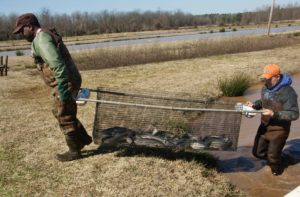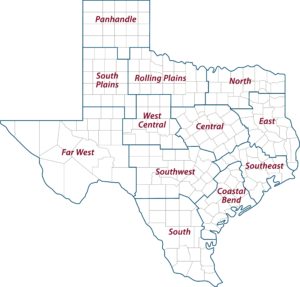Catfish production down but Texas producers faring well
- Writer: Adam Russell, 903-834-6191, adam.russell@ag.tamu.edu
- Contact: Dr. Todd Sink, 979-845-7471, todd.sink@tamu.edu
COLLEGE STATION – Texas catfish production is down, but that’s not bad news for fish producers around the state, said a Texas A&M AgriLife Extension Service expert.
Dr. Todd Sink, AgriLife Extension fisheries specialist, College Station, said Texas catfish producers were slowly entering the annual catfish harvest and production was expected to be down about 5 percent. The drop, however, is attributed to producers’ shift to production of higher value species such as red drum and striped bass.

Catfish harvest is underway in Texas and will escalate as temperatures continue to drop. (Texas A&M AgriLife Extension Service photo by Dr. Todd Sink)
“They’re just seeing better profit margins on those species,” he said. “Catfish prices have been low to stagnant for the past 20 years as production costs have continued to rise, so they’re looking at options.”
Sink said post-harvest live-weight values for catfish, $1.34, was much better than it has been. Texas produces around 19 million pounds of catfish annually and is No. 4 in the nation behind Alabama, Mississippi and Arkansas.
There are 15 major producers in the state, but Sink said there are numerous “mom-and-pop” operations that market local fish to restaurants, grocers and individuals.
Sink said producers harvest fish throughout the year, but major harvests occur each winter as temperatures drop.
“Once the temperature dips below 50 degrees fish stop eating,” he said. “They start losing weight and producers want to take them to market before they start losing money.”
Sink said expectations for above-average temperatures could allow producers to push harvest longer than typical. Producers typically begin harvesting in earnest during November and catfish supplies should build through December.
“Consumers should expect prices to go down as supply numbers increase,” he said.
Sink said competition with Chinese catfish producers has affected U.S. prices some. About 10 percent of catfish in U.S. markets are produced in China, which has transitioned some capacity to production of North American species including channel catfish versus native species to appeal to U.S. consumers.
“If it doesn’t say U.S. farm-raised, there’s a good chance it’s Chinese,” he said. “They’re adapting their production because they can produce fish much cheaper and export it for better prices in the states. At this point they produce about 20-25 percent of the seafood we consume in the U.S.”
AgriLife Extension district reporters compiled the following summaries:
CENTRAL: Warm temperatures following rain helped small grain growth. Overall, winter wheat and oats were doing well. Cotton harvest was completed. Field work for corn planting began. Pastures continued to decline with cooler temperatures. Supplemental feeding was necessary. Livestock and wildlife were active and in good condition. Fly numbers were still high. Stock tank levels showed signs of drought stress. Nearly all counties reported good soil moisture. Overall crop, rangeland and pasture conditions were good in most counties.
ROLLING PLAINS: Temperatures were unusually warm. Cotton harvest came to a halt in some areas due to damp, cloudy days. In drier counties, weather was ideal for cotton harvest. Topsoil moisture was low, and rain was needed. Feral hog movement was up, and there were reports of cotton crop losses. Pastures were dormant, and cattle were on supplemental feed where needed. A few wheat pasture stockers were turned out on adequate forage.
COASTAL BEND: Warm and dry weather continued with a few scattered showers reported. Producers continued to fertilize where moisture was available. Winter oats and ryegrass have come up in some areas. However, lack of measurable rainfall left topsoil in dry condition, and winter pastures continued to be stressed by low soil moisture. Heavy fall armyworm pressure continued to be a problem. Pecan harvest continued. A second crop of rice was being cut, and harvest was expected to continue until mid-December. Some producers were finishing up the last bit of hay cutting for the season. Cattle remained in good condition, and many producers were sending calves to market with slightly higher prices reported, which made for large runs at local auctions.
EAST: Cooler temperatures and sparse rainfall continued across the district. The Anderson County wheat crop made only moderate growth due to a lack of rainfall. Pecan harvest was in full swing with some varieties producing heavy crops. Anderson County battled pecan scab disease on several varieties of pecan trees. Producers across the district who planted late cool-season forages have seen crops start to emerge. Henderson and Smith counties reported large amounts of volunteer ryegrass growing along with fall crops of greens. Pasture and rangeland conditions were mostly fair across the district with the exception of Rusk and Smith counties, which reported good conditions, and Harrison, Marion and Newton counties, which reported poor conditions. Subsoil and topsoil conditions were short in Gregg, Harrison, Marion and Wood counties, with all other counties reporting adequate conditions. Producers continued supplemental feeding with protein, energy and hay throughout the district. Cattle market prices continued to hold firm with classes $2-$3 higher per hundredweight and large numbers at the sale barns. Producers reported livestock body conditions as fair to good. Wild pig damage was reported in Cherokee, Gregg, Henderson, Upshur and Wood counties.
SOUTH PLAINS: Subsoil and topsoil moisture levels continued to dry out. High humidity and cool, damp weather kept farmers out of fields to strip cotton for a couple of days. Yields were average to better than average. Corn, sorghum, sunflower and peanut harvests continued. Winter wheat continued to mature. Pastures and rangeland remained in fair to good condition. Cattle were in good condition.
PANHANDLE: Temperatures were cold one day and warmer the next, then cold again. Soil moisture was short to adequate in most areas. Lipscomb County cotton harvest continued at a slow pace due to high humidity. Corn harvest was complete. Sorghum harvest was still ongoing. Wheat could use some rain. Yields for all crops were above average. Corn yields were 160-180 bushels per acre. Dryland sorghum yielded 3,000-4,000 pounds per acre while irrigated fields yielded 5,000-7,000 pounds per acre with harvest 60 percent completed. Dryland cotton produced 1.5-2 bales per acre while irrigated yielded 2.5-3.5 bales per acre with harvest near 70 percent complete. Rangeland was dormant, and supplemental feeding of cattle continued.
NORTH: There was some precipitation reported by a few counties but no measurable amounts. The moisture was helpful, but much more was needed for the small grains and the annual winter pastures. Small grain planting was 90 percent complete. Temperatures ranged from the mid-80s in the daytime to the low 40s at night. Soil conditions were very dry, with topsoil and subsoil moisture levels ranging from mostly short to adequate, with some counties reporting very short. Livestock were in good condition, and a lot of producers were starting to supplement hay. Cotton harvest continued to be very good, with most fields yielding two bales per acre. Wheat that was planted earlier was doing well, and the producers will be able to turn cattle on those wheat and oat pastures soon. Calving should begin soon.
FAR WEST: Temperatures were in the high 90s with lows in the 30s. Rain reports of 0.1 to 0.5 of an inch was reported. Wind was severe on several days. Pima and upland cotton harvests continued with producers making steady progress. There was still some very good yielding cotton left to be harvested. The wheat crop looked a little better as spraying for fall armyworms relaxed. The last cut of alfalfa was baled. Chili pepper harvesting was underway. Western Schley pecans were expected to be harvested as soon as a decent freeze arrives. Grass was browning and created a high chance of fires due to wind. Cattle maintained body condition scores, and producers continued to feed livestock and wildlife.
WEST CENTRAL: Weather was unseasonably warm and dry. Soil moisture was short. All areas needed rainfall. Stock tank levels continued to drop, and there was concern for those who have no other water sources for livestock. Winter wheat and oats were in mostly good to fair condition. Mild temperatures improved growing conditions for small grains. Many producers had to replant wheat due to armyworm damage. Rain was needed in newly planted fields. Cotton harvest was back in full swing with good harvest conditions. Yield reports were slightly better than projected at average to above average with good grades as well. Mild temperatures and recent rains improved both rangeland and pasture conditions. Warm-season grasses and forages were played out. Cool-season grasses were beginning to grow. Livestock continued to look good and remained in fair to good condition heading into winter. Supplemental feeding increased, and fall cattle work continued.
SOUTHEAST: Livestock were in good condition. Many cattle producers established winter forage. Ratoon rice harvest was complete, and row crop farmers continued field work. Rainfall was needed. In Waller County, a cold front brought windy conditions. Temperatures were slightly above normal. Cooler temperatures were in the forecast. Pasture conditions remained on the poor side; however, winter cover crops such as ryegrass appeared to be coming on strong. Soil-moisture levels throughout the district ranged from adequate to surplus with short being the most common. Rangeland and pasture ratings varied from excellent to very poor with fair being most common.
SOUTHWEST: No report provided.
SOUTH: Conditions were warm, and most of the district did not receive rain. The southernmost areas reported good rains but no measurements. Some western parts of the district reported morning fog and mist. Peanut harvest continued. Wheat planting was complete. Pasture and rangeland conditions remained fair to good and were improving in areas that received recent moisture. Summer perennial grasses were going into dormancy and curing. Native rangeland and improved pastures continued to provide good supplies of forage, which eliminated any supplemental feeding. A few areas reported poor rangeland and pasture conditions and supplemental feeding of cattle. Body condition scores on cattle remained good. Some cow herds were being worked, and calves were being shipped. Vegetable crops were done for the season in most counties, and Coastal Bermuda grass was dormant. In Starr County, fall vegetable crops were progressing well. In Zavala County, fresh market baby leaf spinach harvest was very active. Cabbage harvest started in early planted fields. Onion and tomato crops were maturing in southern parts of the district. Wheat and oats under irrigation made good progress. Pecan harvest was complete. Armyworm pressure on wheat and oats was reduced following chemical control applications, but some areas reported damages from the pest. Most fields were prepared for the winter. The sales barn in Brooks County marketed 830 head and prices were down.
-30-
